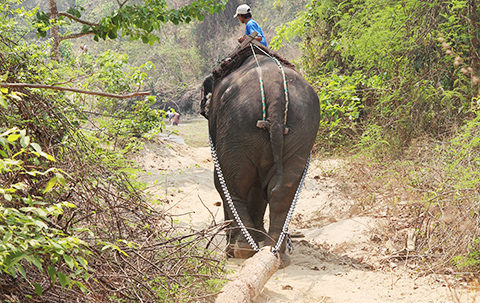Placing a wild elephant in captivity can shorten its life by several years, according to a new study published in Nature Communications based on records of 5,000 logging elephants in Myanmar.
The researchers found that captured and tamed wild elephants had median lifespans that were three to seven years shorter than those of elephants born in captivity.
“Capturing elephants to sustain captive populations is, consequently, detrimental, because it not just reduces wild populations of this endangered species, but it also cannot provide a viable solution to sustain captive populations,” said senior investigator Virpi Lummaa of the University of Turku in Finland in a press release for the study. “These wild-caught animals live shorter lives and reproduce poorly in captivity.”
Researchers posited that changes in the elephants’ social environments or trauma from being captured may be the causes of their shorter lifespans. In Myanmar, humans capture wild elephants in a number of ways, including driving them into a stockade, lassoing single elephants, or immobilization them via sedation. Each method was shown to contribute to shortened elephant lifespans.
Scientists estimate that as many as one third of Asian elephants, or 15,000 individuals, are currently living in captivity.
“We ought to find alternative and better methods to boost captive populations of elephants. Even today, over 60 percent of elephants in zoos are captured from the wild, and about a third of all remaining Asian elephants now live in captivity,” lead author Mirkka Lahdenpera from the University of Turku said.
The report was published just ahead of World Elephant Day, which falls on Sunday. Conservation groups around the world will hold events to call attention to the plight of Asian and African elephants.
In addition to being threatened by loggers for their labor, elephants in Myanmar are also frequently killed for their ivory and their skin, which are sold primarily in neighboring China. This year was the first year since 2014 that killings of wild elephants did not rise, thanks to conservation efforts by police, Forestry Department staff, local administrators, conservation professionals, and collaboration with local communities where elephants live.
Official estimates put Myanmar’s wild elephant population between 1,400 to 2,000 individuals.





Reader Interactions